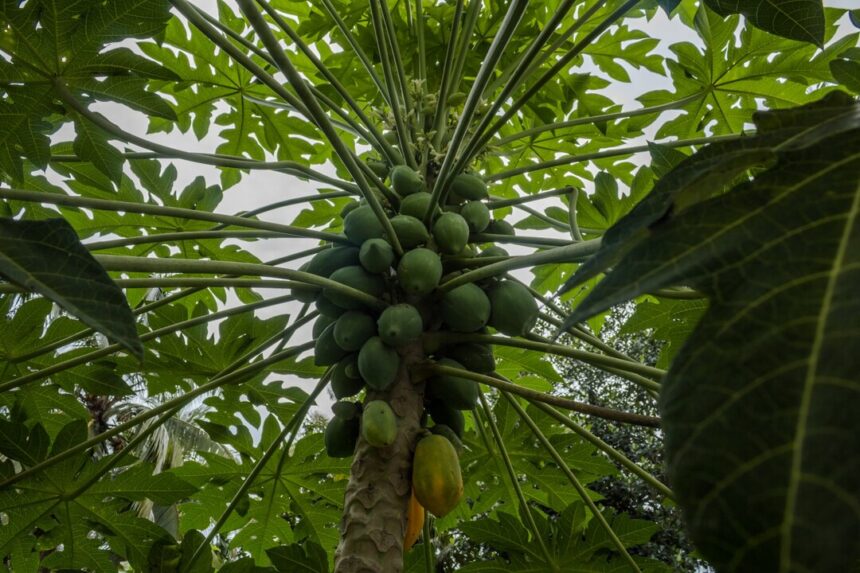Papayas, with their sweet and tropical flavor, are a beloved fruit enjoyed by many in South Africa. Cultivated in various regions across the country, papayas thrive in the warm climate and are a valuable crop for farmers. To ensure optimal quality and yield, farmers employ a range of techniques and practices designed to enhance growth, productivity, and fruit quality. Let’s explore some of the key techniques for enhancing the quality and yield of papayas in South Africa:
1. Site Selection and Soil Preparation:
Choosing the right site for papaya cultivation is crucial for success. Papayas prefer well-drained soil with good fertility and a pH range of 6.0 to 6.5. Farmers should select sites with ample sunlight and protection from strong winds, as papaya plants are susceptible to wind damage. Prior to planting, soil should be thoroughly prepared with organic matter and balanced fertilization to provide the necessary nutrients for healthy plant growth.
2. Proper Plant Spacing and Pruning:
Papaya plants require adequate spacing to ensure optimal growth and fruit development. Proper plant spacing allows for sufficient air circulation, sunlight penetration, and access to nutrients and water. Additionally, pruning can help manage plant size, promote branching, and improve fruit quality. Removing suckers and lower leaves can redirect the plant’s energy towards fruit production, resulting in larger, sweeter fruit.
3. Irrigation Management:
Papayas have shallow root systems and are sensitive to water stress, making proper irrigation management essential. Drip irrigation or micro-sprinklers are recommended to deliver water directly to the root zone while minimizing water waste and reducing the risk of foliar diseases. Irrigation scheduling should be adjusted based on weather conditions, soil moisture levels, and stage of plant growth to ensure consistent moisture throughout the growing season.
4. Fertilization and Nutrient Management:
Appropriate fertilization is crucial for supporting healthy growth and maximizing yield in papaya cultivation. Papayas have high nutrient requirements, particularly for nitrogen, phosphorus, and potassium. Regular soil testing can help determine nutrient deficiencies and guide fertilization practices. In addition to macronutrients, papayas also require micronutrients such as calcium, magnesium, and boron for optimal growth and fruit development.
5. Pest and Disease Control:
Pests and diseases can significantly impact papaya production and reduce fruit quality and yield. Common pests affecting papayas in South Africa include fruit flies, aphids, mealybugs, and spider mites, while diseases such as powdery mildew, anthracnose, and papaya ringspot virus can also pose challenges. Integrated pest management (IPM) practices, including cultural controls, biological controls, and chemical interventions as a last resort, can help minimize pest and disease pressure while reducing environmental impact.
6. Pollination Enhancement:
Papayas are typically dioecious, meaning they have separate male and female flowers on different plants. To ensure successful pollination and fruit set, farmers should maintain a proper ratio of male to female plants and provide habitat for pollinators such as bees and butterflies. Hand pollination can also be employed to increase fruit set and yield, especially in areas with limited insect activity or during adverse weather conditions.
7. Fruit Thinning and Harvesting:
Thinning excess fruit and harvesting at the right time are essential for maximizing fruit size, quality, and yield. Thinning should be done when the fruit is small, leaving only one or two fruits per cluster to develop to maturity. Harvesting should be done when the fruit reaches the desired size, color, and firmness, typically when the skin turns yellow or orange and yields slightly to gentle pressure. Harvesting too early can result in underripe fruit with poor flavor and texture, while harvesting too late can lead to overripe fruit with reduced shelf life.
In conclusion, by employing these techniques and practices, farmers in South Africa can enhance the quality and yield of papayas, resulting in higher profits and greater market competitiveness. By prioritizing site selection, soil preparation, proper plant spacing, irrigation management, fertilization, pest and disease control, pollination enhancement, and fruit thinning, farmers can produce premium-quality papayas that meet consumer demand for fresh, flavorful, and nutritious fruit.
Join 'Farmers Mag' WhatsApp Channel
Get the latest Farming news and tips delivered straight to your WhatsApp
CLICK HERE TO JOIN






